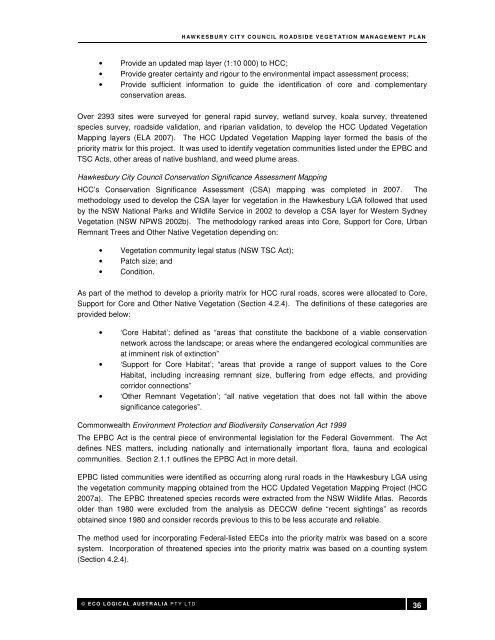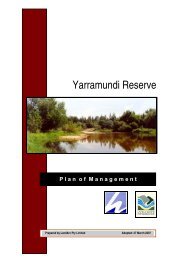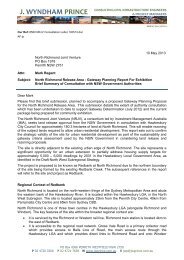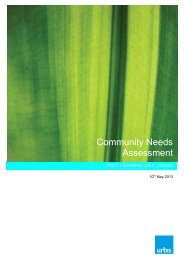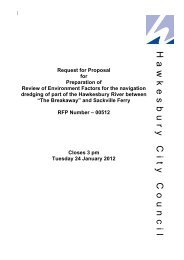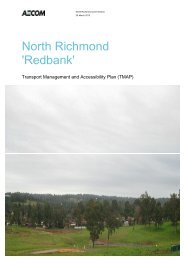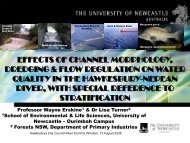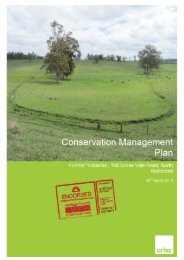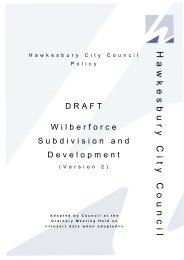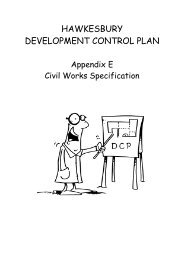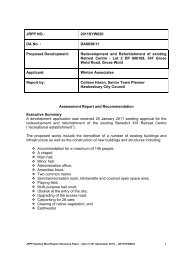Attachment 1 to Item 53 - Roadside Vegetation Management Plan
Attachment 1 to Item 53 - Roadside Vegetation Management Plan
Attachment 1 to Item 53 - Roadside Vegetation Management Plan
You also want an ePaper? Increase the reach of your titles
YUMPU automatically turns print PDFs into web optimized ePapers that Google loves.
H AW K E S B U R Y C IT Y C O U N C IL R O AD S ID E V E G E T AT IO N M AN AG E M E N T P L AN<br />
• Provide an updated map layer (1:10 000) <strong>to</strong> HCC;<br />
• Provide greater certainty and rigour <strong>to</strong> the environmental impact assessment process;<br />
• Provide sufficient information <strong>to</strong> guide the identification of core and complementary<br />
conservation areas.<br />
Over 2393 sites were surveyed for general rapid survey, wetland survey, koala survey, threatened<br />
species survey, roadside validation, and riparian validation, <strong>to</strong> develop the HCC Updated <strong>Vegetation</strong><br />
Mapping layers (ELA 2007). The HCC Updated <strong>Vegetation</strong> Mapping layer formed the basis of the<br />
priority matrix for this project. It was used <strong>to</strong> identify vegetation communities listed under the EPBC and<br />
TSC Acts, other areas of native bushland, and weed plume areas.<br />
Hawkesbury City Council Conservation Significance Assessment Mapping<br />
HCC’s Conservation Significance Assessment (CSA) mapping was completed in 2007. The<br />
methodology used <strong>to</strong> develop the CSA layer for vegetation in the Hawkesbury LGA followed that used<br />
by the NSW National Parks and Wildlife Service in 2002 <strong>to</strong> develop a CSA layer for Western Sydney<br />
<strong>Vegetation</strong> (NSW NPWS 2002b). The methodology ranked areas in<strong>to</strong> Core, Support for Core, Urban<br />
Remnant Trees and Other Native <strong>Vegetation</strong> depending on:<br />
• <strong>Vegetation</strong> community legal status (NSW TSC Act);<br />
• Patch size; and<br />
• Condition.<br />
As part of the method <strong>to</strong> develop a priority matrix for HCC rural roads, scores were allocated <strong>to</strong> Core,<br />
Support for Core and Other Native <strong>Vegetation</strong> (Section 4.2.4). The definitions of these categories are<br />
provided below:<br />
• ‘Core Habitat’; defined as “areas that constitute the backbone of a viable conservation<br />
network across the landscape; or areas where the endangered ecological communities are<br />
at imminent risk of extinction”<br />
• ‘Support for Core Habitat’; “areas that provide a range of support values <strong>to</strong> the Core<br />
Habitat, including increasing remnant size, buffering from edge effects, and providing<br />
corridor connections”<br />
• ‘Other Remnant <strong>Vegetation</strong>’; “all native vegetation that does not fall within the above<br />
significance categories”.<br />
Commonwealth Environment Protection and Biodiversity Conservation Act 1999<br />
The EPBC Act is the central piece of environmental legislation for the Federal Government. The Act<br />
defines NES matters, including nationally and internationally important flora, fauna and ecological<br />
communities. Section 2.1.1 outlines the EPBC Act in more detail.<br />
EPBC listed communities were identified as occurring along rural roads in the Hawkesbury LGA using<br />
the vegetation community mapping obtained from the HCC Updated <strong>Vegetation</strong> Mapping Project (HCC<br />
2007a). The EPBC threatened species records were extracted from the NSW Wildlife Atlas. Records<br />
older than 1980 were excluded from the analysis as DECCW define “recent sightings” as records<br />
obtained since 1980 and consider records previous <strong>to</strong> this <strong>to</strong> be less accurate and reliable.<br />
The method used for incorporating Federal-listed EECs in<strong>to</strong> the priority matrix was based on a score<br />
system. Incorporation of threatened species in<strong>to</strong> the priority matrix was based on a counting system<br />
(Section 4.2.4).<br />
© E C O L O G I C AL AU S T R AL I A P T Y L T D<br />
36


